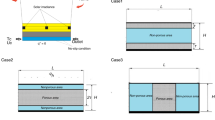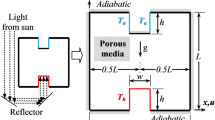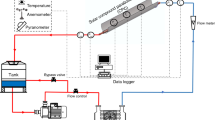Abstract
Concentrator photovoltaic thermal system is one of the heat and power generation systems that have received special attention in recent decades. In this paper, concentrator photovoltaic thermal cell with the effect of Al2O3 nanofluid flow in porous channel has been investigated under transient heat flux. The system is analyzed from energy and exergy viewpoint, and also the first and second laws of thermodynamics efficiencies are calculated. The governing equations are continuity, Brinkman momentum and energy conservation equations considering the transient solar flux using parabolic dish concentrator over a day in Mashhad city. The numerical modeling is based on the finite element method. The numerical results show that the Nusselt number, normalized temperature and electrical efficiency of the presented model have an acceptable agreement with experimental data. Efficiency of the photovoltaic cell increases with increasing the Reynolds number as the difference between the highest and the lowest efficiency value is 5% at 12 p.m. In addition, with increasing Reynolds number, the first law of thermodynamics efficiency increases due to porosity and permeability effects of the porous channel cooling. The maximum difference between highest and the lowest value for first law efficiency is 49.4% at Re = 110. The second law of thermodynamics efficiency decrease as Reynolds number increases as the highest value is 4.2% and the lowest is 2.8% at Re = 20 and Re = 10, respectively.
















Similar content being viewed by others
Notes
Multi-frontal massively parallel sparse direct solver.
Abbreviations
- A :
-
Area (m2)
- c p :
-
Heat capacity (J kg−1 K−1)
- CR:
-
Concentration ratio
- D :
-
Concentrator diameter (m)
- f :
-
Focal length (m)
- H :
-
Height (mm)
- h :
-
Convective heat transfer coefficient (W m−2 K−1)
- I :
-
Irradiation (W m−2)
- K :
-
Permeability (m2)
- k :
-
Thermal conductivity (W m−1 K−1)
- L :
-
Length (mm)
- \(\dot{m}\) :
-
Mass flow rate (gr s−1)
- P :
-
Power (w)
- P :
-
Pressure (kg m−1 s−2)
- Q′:
-
Heat flux (W m−2)
- Re:
-
Reynolds number
- r :
-
Radius (m)
- T :
-
Temperature (K)
- t :
-
Time (h)
- u :
-
Velocity-x (m s−1)
- v :
-
Velocity-y (m s−1)
- X :
-
Length (m)
- Y :
-
Height (m)
- β :
-
Thermal coefficient
- \({\varvec{\upvarepsilon}}\) :
-
Second law efficiency
- ε :
-
Porosity
- η :
-
First law efficiency
- θ :
-
Angel (°)
- ρ :
-
Density (kg m−3)
- \(\rho^{{\prime }}\) :
-
Reflectivity (%)
- ϕ :
-
Angel (°)
- μ :
-
Dynamic viscosity (kg m−1 s−1)
- \(\nabla\) :
-
Gradient
- Al:
-
Aluminum
- amb:
-
Ambient
- CPVT:
-
Concentration photovoltaic thermal
- c:
-
Channel
- cell:
-
PV cell
- eff:
-
Effective
- in:
-
Inlet
- nf:
-
Nanofluid
- out:
-
Outlet
- ref:
-
Reference
- rim:
-
Rim angel
- s:
-
SUN
- w:
-
Wall
References
Deymi-Dashtebayaz M, Maddah S, Goodarzi M, Maddah O. Investigation of the effect of using various HFC refrigerants in geothermal heat pump with residential heating applications. J Therm Anal Calorim. 2020. https://doi.org/10.1007/s10973-020-09539-5.
Ebrahimi-Moghadam A, Deymi-Dashtebayaz M, Jafari H, Niazmand A. Energetic, exergetic, environmental and economic assessment of a novel control system for indirect heaters in natural gas city gate stations. J Therm Anal Calorim. 2020;1:1–16. https://doi.org/10.1007/s10973-020-09413-4.
Farzaneh-Gord M, Arabkoohsar A, Deymi-Dashtebayaz M, Machado L, Koury RNN. Energy and exergy analysis of natural gas pressure reduction points equipped with solar heat and controllable heaters. Renew Energy. 2014;72:258–70. https://doi.org/10.1016/j.renene.2014.07.019.
Deymi-Dashtebayaz M, Tayyeban E. Multi objective optimization of using the surplus low pressure steam from natural gas refinery in the thermal desalination process. J Clean Prod. 2019;238:117945. https://doi.org/10.1016/j.jclepro.2019.117945.
Lovegrove K, Csiro WS. Introduction to concentrating solar power (CSP) technology. Concentrating Solar Power Technology. New York: Elsevier; 2012. p. 3–15.
Sharaf OZ, Orhan MF. Concentrated photovoltaic thermal (CPVT) solar collector systems: part I—fundamentals, design considerations and current technologies. Renew Sustain Energy Rev. 2015;50:1500–65. https://doi.org/10.1016/j.rser.2015.05.036.
Karathanassis IK, Papanicolaou E, Belessiotis V, Bergeles GC. Design and experimental evaluation of a parabolic-trough concentrating photovoltaic/thermal (CPVT) system with highefficiency cooling. Renew Energy. 2017;101:467–83. https://doi.org/10.1016/j.renene.2016.09.013.
Wang G, Chen Z, Hu P. Design and experimental investigation of a Multi-segment plate concentrated photovoltaic solar energy system. Appl Therm Eng. 2017;116:147–52. https://doi.org/10.1016/j.applthermaleng.2017.01.045.
Ma X, Zheng H, Chen Z. An investigation on a compound cylindrical solar concentrator (CCSC). Appl Therm Eng. 2017. https://doi.org/10.1016/j.applthermaleng.2017.04.030.
Shadmehri M, Narei H, Ghasempoura R, Shafii MB. Numerical simulation of a concentrating photovoltaic-thermal solar system combined with thermoelectric modules by coupling Finite Volume and Monte Carlo Ray-Tracing methods. Energy Convers Manag. 2018;172:343–56. https://doi.org/10.1016/j.enconman.2018.07.034.
Alizadeh H, Ghasempour R, Shafii MB, Ahmadi MH, Yan W-M, Nazari MA. Numerical simulation of PV cooling by using single turn pulsating heat pipe. Int J Heat Mass Transf. 2018;127:203–8. https://doi.org/10.1016/j.ijheatmasstransfer.2018.06.108.
Kandilli C, Külahlı G. Performance analysis of a concentrated solar energy for lightingpower generation combined system based on spectral beam splitting. Renew Energy. 2017;101:713–27. https://doi.org/10.1016/j.renene.2016.09.032.
Kandilli C. Performance analysis of a novel concentrating photovoltaic combined system. Energy Convers Manag. 2013;67:186–96. https://doi.org/10.1016/j.enconman.2012.11.020.
Sanaye S, Sarrafi A. Optimization of combined cooling, heating and power generation by a solar system. Renew Energy. 2015;80:699–712. https://doi.org/10.1016/j.renene.2015.02.043.
Ferchichi S, Kessentini H, Morales-Ruiz S, Rigola J, Bouden C, Olivab A. Thermal and fluid dynamic analysis of Direct Steam Generation Parabolic Trough Collectors. Energy Convers Manag. 2019;196:467–83. https://doi.org/10.1016/j.enconman.2019.05.107.
Günther M, Shahbazfar R. Solar dish technology. Chapter 7, Advanced CSP teaching materials. Enermena. 2018;1–63.
Moraveji MK, Darabi M, Haddad SMH, Davarnejad R. Modeling of convective heat transfer of a nanofluid in the developing region of tube flow with computational fluid dynamics. Int Commun Heat Mass Transf. 2011;38:1291–5. https://doi.org/10.1016/j.icheatmasstransfer.2011.06.011.
Deymi-Dashtebayaz M, Akhoundi M, Ebrahimi-Moghadam A, Moghadam AJ, Arabkoohsar A, Farzaneh-Gord M. Thermo-hydraulic analysis and optimization of CuO/water nanofluid inside helically dimpled heat exchangers. J Therm Anal Calorim. 2020;1:1–16. https://doi.org/10.1007/s10973-020-09398-0.
Xu Z, Kleinstreuer C. Concentration photovoltaic–thermal energy co-generation system using nanofluids for cooling and heating. Energy Convers Manag. 2014;87:504–12. https://doi.org/10.1016/j.enconman.2014.07.047.
Fayaz H, Nasrina R, Rahim NA, Hasanuzzamana M. Energy and exergy analysis of the PVT system: Effect of nanofluid flow rate. Solar Energy. 2018;169:217–30. https://doi.org/10.1016/j.solener.2018.05.004.
Okonkwo EC, Essien EA, Akhayere E, Abid M, Kavaz D, Ratlamwal TAH. Thermal performance analysis of a parabolic trough collector using waterbased green-synthesized nanofluids. Sol Energy. 2018;170:658–70. https://doi.org/10.1016/j.solener.2018.06.012.
An W, Li J, Ni J, Taylor RA, Zhu T. Analysis of a temperature dependent optical window for nanofluid-based spectral splitting in PV/T power generation applications. Energy Convers Manag. 2017;151:23–31. https://doi.org/10.1016/j.enconman.2017.08.080.
Mousa OB, Taylor RA, Shirazi A. Multi-objective optimization of solar photovoltaic and solar thermal collectors for industrial rooftop applications. Energy Convers Manag. 2019;195:392–408. https://doi.org/10.1016/j.enconman.2019.05.012.
Fanaee SA, Rezapour M. The modeling of constant/variable solar heat flux into a porous coil with concentrator. J Solar Energy Eng (ASME). 2020;142(1):9. https://doi.org/10.1115/1.4044126.
Radwan A, Ahmed M, Ookawara S. Performance enhancement of concentrated photovoltaic systems using a microchannel heat sink with nanofluids. Energy Convers Manag. 2016;119:289–303. https://doi.org/10.1016/j.enconman.2016.04.045.
Alobaida M, Hughesa B, Calautitb JK, O’Connora D, Heyes A. A review of solar driven absorption cooling with photovoltaic thermal systems. Renew Sustain Energy Rev. 2017;76:728–42. https://doi.org/10.1016/j.rser.2017.03.081.
Abdallah SR, Saidani-Scott H, Abdellatif OE. Performance analysis for hybrid PV/T system using low concentration MWCNT (water-based) nanofluid. Solar Energy. 2019;181:108–15. https://doi.org/10.1016/j.solener.2019.01.088.
Hader M, Al-Kouz W. Performance of a hybrid photovoltaic/thermal system utilizing water-Al2O3 nanofluid and fins. Int J Energy Res. 2019;43:219–30. https://doi.org/10.1002/er.4253.
Cummins BM, Chinthapatla R, Ligler FS, Walker GM. Time-dependent model for fluid flow in porous materials with multiple pore sizes. Anal Chem. 2017;89(8):4377–81. https://doi.org/10.1021/acs.analchem.6b04717.
Diersch H-JG. Finite element modeling of flow, mass and heat transport in porous and fractured media. Berlin: Springer; 2014.
Furman EL, Finkelstein AB, Cherny ML. Permeability of aluminium foams produced by replication casting. Metals. 2013;3:49–57. https://doi.org/10.3390/met3010049.
Bayomy AM, Saghir MZ. Heat transfer characteristics of aluminum metal foam subjected to a pulsating/steady water flow: experimental and numerical approach. Int J Heat Mass Transf. 2016;97:318–36. https://doi.org/10.1016/j.ijheatmasstransfer.2016.02.009.
Bayomy AM, Saghir MZ. Experimental study of using c-Al2O3–water nanofluid flow through aluminum foam heat sink: comparison with numerical approach. Int J Heat Mass Transf. 2017;107:181–203. https://doi.org/10.1016/j.ijheatmasstransfer.2016.11.037.
Dukhan N, Chen KC. Heat transfer measurements in metal foam subjected to constant heat flux. Exp Therm Fluid Sci. 2007. https://doi.org/10.1016/j.expthermflusci.2007.08.004.
Anoop KB, Sundararajan T, Das SK. Effect of particle size on the convective heat transfer in nanofluid in the developing region. Int J Heat Mass Transf. 2009;52:2189–95. https://doi.org/10.1016/j.ijheatmasstransfer.2007.11.063.
Xu H, Zhao C, Vafai K. Analytical study of flow and heat transfer in an annular porous medium subject to asymmetrical heat fluxes. Heat Mass Transf. 2017;53(8):2663–76.
Awin Y, Dukhan N. Experimental performance assessment of metal-foam flow fields for proton exchange membrane fuel cells. Appl Energy. 2019;252:113458. https://doi.org/10.1016/j.apenergy.2019.113458.
Chen X, Xia X, Sun C, Wang F, Liu R. Performance evaluation of a double-pipe heat exchanger with uniform and graded metal foams. Heat Mass Transf. 2019. https://doi.org/10.1007/s00231-019-02700-3.
Ghahremannezhad A, Vafai K. Thermal and hydraulic performance enhancement of microchannel heat sinks utilizing porous substrates. Int J Heat Mass Transf. 2018;122:1313–26. https://doi.org/10.1016/j.ijheatmasstransfer.2018.02.024.
Nield DA, Bejan A. convection in porous media. 3rd ed. New York: Springer; 2006.
Bellos E, Tzivanidis C. Investigation of a nanofluid-based concentrating thermal photovoltaic with a parabolic reflector. Energy Convers Manag. 2019;180:171–82. https://doi.org/10.1016/j.enconman.2018.11.008.
Gu Y, Zhang X, Myhren JA, Han M, Chen X, Yuan Y. Techno-economic analysis of a solar photovoltaic/thermal (PV/T) concentrator for building application in Sweden using Monte Carlo method. Energy Convers Manag. 2018;165:8–24. https://doi.org/10.1016/j.enconman.2018.03.043.
Bellos E, Tzivanidis C, Nikolaou N. Investigation and optimization of a solar assisted heat pump driven by nanofluid-based hybrid PV. Energy Convers Manag. 2019;198:111831. https://doi.org/10.1016/j.enconman.2019.111831.
Electronics L. LG305N1C-B3. In: www.lg-solar.com, www.lgsolarusa.com, editors. U.S.A. Inc2014.
Author information
Authors and Affiliations
Corresponding author
Additional information
Publisher's Note
Springer Nature remains neutral with regard to jurisdictional claims in published maps and institutional affiliations.
Rights and permissions
About this article
Cite this article
Deymi-Dashtebayaz, M., Rezapour, M. The effect of using nanofluid flow into a porous channel in the CPVT under transient solar heat flux based on energy and exergy analysis. J Therm Anal Calorim 145, 507–521 (2021). https://doi.org/10.1007/s10973-020-09796-4
Received:
Accepted:
Published:
Issue Date:
DOI: https://doi.org/10.1007/s10973-020-09796-4




